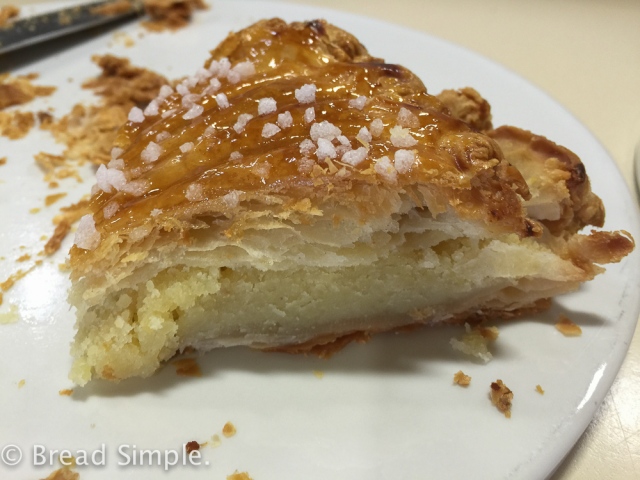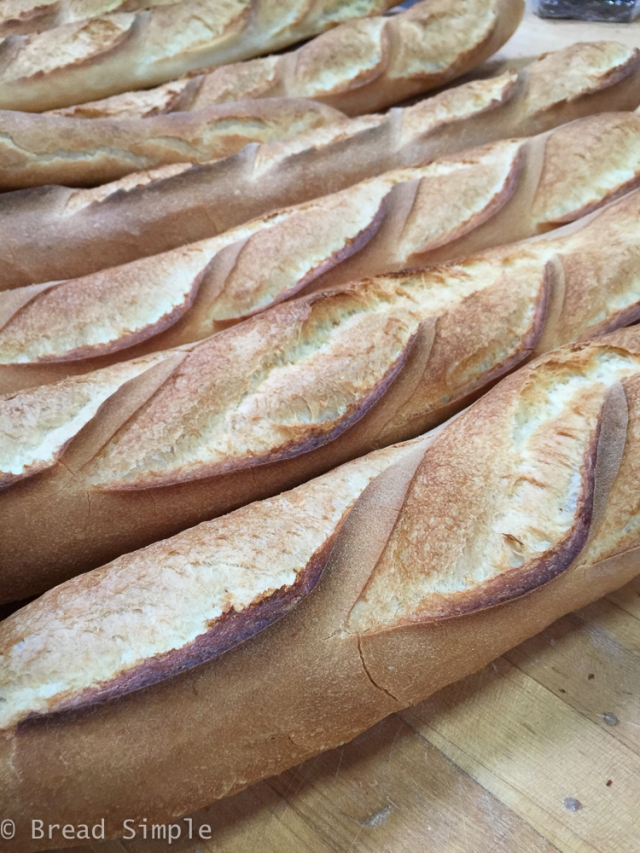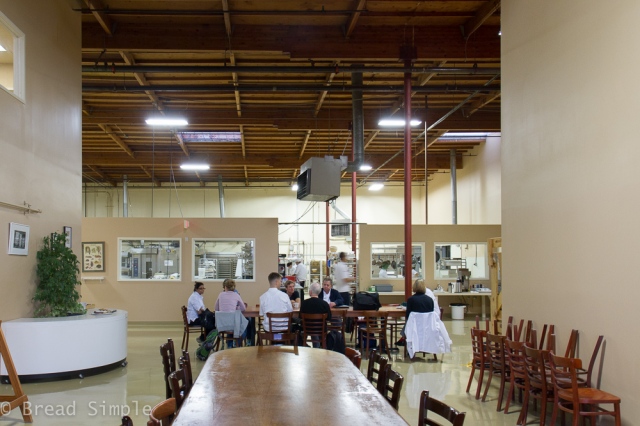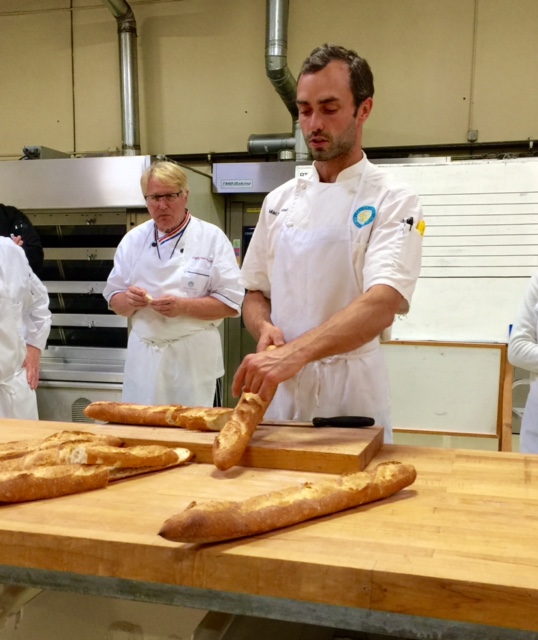Same Formula, Different Amount, Hydration and Feeding of Levains, Day #2
In today’s lesson, we will have the opportunity to compare breads with the following differences:
- one-day feeding versus two-day feeding levains,
- liquid versus stiff levains, and
- different amounts of levain in the final dough mix.
In lecture, Miyuki elaborates on the two types of bacteria involved in the sourdough process:
a) homofermentative bacteria which favors high hydration and warm temperatures (describes liquid levain), and produces mostly lactic acid (sweeter flavor), and
2) heterofermentative bacteria which favors lower hydration and low temperatures (describes stiff levain), and produces both lactic and acetic acids as well as gas production.
A key difference is the growth rate, temperature and hydration. The homofermentative bacteria which favor water and warmth develops earlier. Also the characteristic of acetic acid in the starter takes longer to develop than lactic acid. Hence, the reasons why it takes one to two weeks for a balance of wild yeast and bacterias to develop which will contribute to the complex flavors derived from lactic/acid production.
On a side note, the infamous Boudin sourdough uses stiff levain which is fed once a day and stored in 45-50F temperature. Note the sharp acidity. (NOTE: On my day off from SFBI, I took a tour of the Boudin Bakery (of course I did) and was impressed with the history of sourdough in San Francisco and equally impressed with the detailed, easy to understand explanation of sourdough and bread baking process to the general public. The Boudin Bakery Tour warrants its own post. More on that later.
Additionally, Miyuki explained baker’s percentage using preferment. By deciding the percentage of levain in the final dough, we can determine the amount in Kg of the amount of preferment to make the previous day for the following day’s bake.
HANDS-ON / SKILLS TRAINING:
Day #2, we started to feed the culture while increasing the water amount. The higher hydration is to promote enzyme activity so that there will be sufficient sugars (food) for the wild yeast to thrive. 
Today, we mixed four different dough formulas in the mixer utilizing similar fermentation time, same number of folds, and similar final proof time. We reshaped to boules (round), and after 30 minutes of rest, we shaped the boules into batards. The four different dough formulas had individual preferments, varying in how often it was fed and the amount used in the final dough.
These different preferments result in using different ranges of hydration, amount of salt and amount of yeast.
1) One-Feed Stiff ,50% means the stiff levain was fed once( yesterday), rested overnight, and added to the final dough (today) for a bake. 50% of stiff levain was added to final dough formula.
2) Two -Feed Liquid, 50% means the liquid levain was fed twice yesterday (once in the morning/once in the afternoon), rested overnight, and added to the final dough (today) for a bake. 50% of liquid levain was added to final dough formula.
3) Two-Feed Stiff, 70% means the stiff levain was fed twice yesterday (once in the morning/once in the afternoon), rested overnight, and added to the final dough (today) for a bake. 70% means 70% of stiff levain was added to final dough formula.
4) Two-Feed Stiff, 40% means the stiff levain was fed twice yesterday (once in the am/once in the pm), rested overnight, and added to final dough (today) for a bake. 40% means 40% of stiff levain was added to final dough formula.
Each of us would have the opportunity to pre-shape, shape, score, and bake 5 (five) loaves of each type of bread formula. That’s a lot of practice time in shaping a batard.
Notice the active fermentation process inside the dough
Dividing and weighing dough prior to preshape

Miyuki instructs proper slashing with razor blade
Transferring loaves from the couch to the deck oven
Nice blistering from the acidity
We started pre-shaping with the One-Feed Stiff and worked out way to the fourth formula. Then, we shaped each form into a batard, working our way to through the formulas. After resting for an hour, we began the scoring, loading, and baking. This is the beauty of taking a workshop! Having the hands-on experience of pre-shaping, shaping, scoring, baking and then, seeing the results (not to mention tasting!) is an invaluable lesson.
We learned how to perpetuate a starter, both liquid and stiff. Also, we discussed converting a liquid starter into a stiff starter and vice versa. For busy travelers like myself, I learned how to make a “dry” a liquid starter and replenish into a liquid starter upon arrival at the destination.
The four formulas we worked on today were a combination of levain and instant dry yeast. It’s possible to bake these breads without using baker’s or commercial yeast. Increasing fermentation time and final proof times well as maintaining proper Desired Dough Temperature (DDT) are critical in the success of baking bread formulas without baker’s yeast. For the sake of time, I believe we used wild yeast and IDY to speed up the process so that we can bake breads today. However, to develop an even more dramatic flavor, these breads can be proofed or retarded overnight in the refrigerator.
EVALUATION OF END PRODUCTS:
It was interesting to see the subtle nuances made in the flavors of the bread based on the preferments. The flavor of the One-Feed, Stiff Levain, 50% had strong acid tones, whereas the Two-feed, liquid levain, 50% produced milder flavor. Feeding the starter more will decrease the acidity of the preferment.

Comparing the aroma and flavor of each formula
The Two-Feed, 70% Stiff Levain offered more acidity due to the presence of more alcohol producing stronger flavors compared to the Two-Feed, 40% Stiff levain. Using more leaven in the final dough will add more complexity to the taste of the final product.
Evidently, the frequency of feeding the starter has more impact on bread flavor than the amount of levain added to the final dough mix. Also, the use of liquid versus firm starter makes a difference in the balance of lactic/acetic flavor in the finished product. The firm starter will be more acidic.
Two seconds of steam makes all the difference








































































































